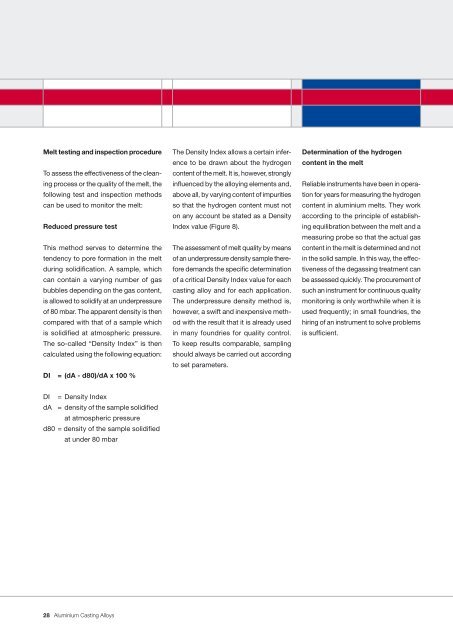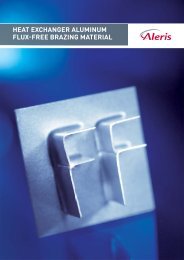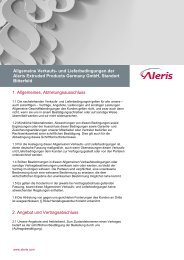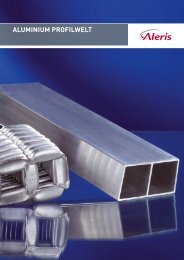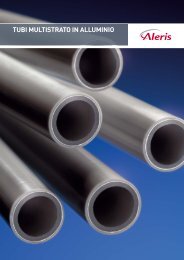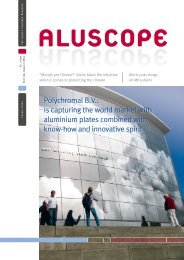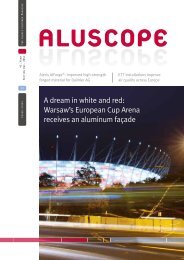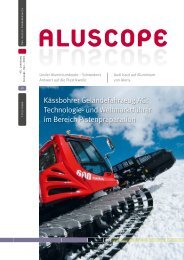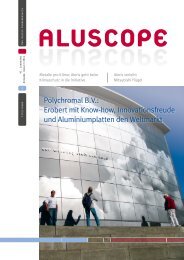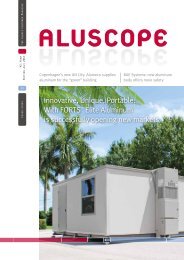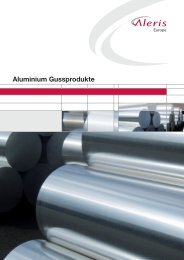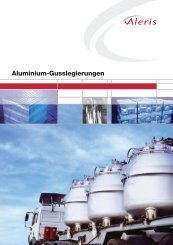Create successful ePaper yourself
Turn your PDF publications into a flip-book with our unique Google optimized e-Paper software.
Melt testing and inspection procedure<br />
To assess the effectiveness of the clean-<br />
ing process or the quality of the melt, the<br />
following test and inspection methods<br />
can be used to monitor the melt:<br />
Reduced pressure test<br />
This method serves to determine the<br />
tendency to pore formation in the melt<br />
during solidifi cation. A sample, which<br />
can contain a varying number of gas<br />
bubbles depending on the gas content,<br />
is allowed to solidify at an underpressure<br />
of 80 mbar. The apparent density is then<br />
compared with that of a sample which<br />
is solidifi ed at atmospheric pressure.<br />
The so-called “Density Index” is then<br />
calculated using the following equation:<br />
DI = (dA - d80)/dA x 100 %<br />
DI = Density Index<br />
dA = density of the sample solidifi ed<br />
at atmospheric pressure<br />
d80 = density of the sample solidifi ed<br />
at under 80 mbar<br />
28<br />
<strong>Aluminium</strong> <strong>Casting</strong> <strong>Alloys</strong><br />
The Density Index allows a certain inference<br />
to be drawn about the hydrogen<br />
content of the melt. It is, however, strongly<br />
infl uenced by the alloying elements and,<br />
above all, by varying content of impurities<br />
so that the hydrogen content must not<br />
on any account be stated as a Density<br />
Index value (Figure 8).<br />
The assessment of melt quality by means<br />
of an underpressure density sample therefore<br />
demands the specifi c determination<br />
of a critical Density Index value for each<br />
casting alloy and for each application.<br />
The underpressure density method is,<br />
however, a swift and inexpensive method<br />
with the result that it is already used<br />
in many foundries for quality control.<br />
To keep results comparable, sampling<br />
should always be carried out according<br />
to set parameters.<br />
Determination of the hydrogen<br />
content in the melt<br />
Reliable instruments have been in operation<br />
for years for measuring the hydrogen<br />
content in aluminium melts. They work<br />
according to the principle of establishing<br />
equilibration between the melt and a<br />
measuring probe so that the actual gas<br />
content in the melt is determined and not<br />
in the solid sample. In this way, the effectiveness<br />
of the degassing treatment can<br />
be assessed quickly. The procurement of<br />
such an instrument for continuous quality<br />
monitoring is only worthwhile when it is<br />
used frequently; in small foundries, the<br />
hiring of an instrument to solve problems<br />
is suffi cient.


